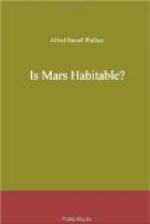This highly volcanic structure can, I think, be well explained by an origin such as that attributed to it by Sir George Darwin, and which has been so well described by Sir Robert Ball in his small volume, Time and Tide. These astronomers adduce strong evidence that the earth once rotated so rapidly that the equatorial protuberance was almost at the point of separation from the planet as a ring. Before this occurred, however, the tension was so great that one large portion of the protuberance where it was weakest broke away, and began to move around the earth at some considerable distance from it. As about 1/50 of the bulk of the earth thus escaped, it must have consisted of a considerable portion of the solid crust and a much larger quantity of the liquid or semi-liquid interior, together with a proportionate amount of the gases which we know formed, and still form, an important part of the earth’s substance.
As the surface layers of the earth must have been the lightest, they would necessarily, when broken up by this gigantic convulsion, have come together to form the exterior of the new satellite, and be soon adjusted by the forces of gravity and tidal disturbance into a more or less irregular spheroidal form, all whose interstices and cavities would be filled up and connected together by the liquid or semi-liquid mass forced up between them. Thence-forward, as the moon increased its distance and reduced its time of rotation, in the way explained by Sir Robert Ball, there would necessarily commence a process of escape of the imprisoned gases at every fissure and at all points and lines of weakness, giving rise to numerous volcanic outlets, which, being subjected only to the small force of lunar gravity (only one-sixth that of the earth), would, in the course of ages, pile up those gigantic cones and ridges which form its great characteristic.
But this small gravitative power of the moon would prevent its retaining on its surface any of the gases forming our atmosphere, which would all escape from it and probably be recaptured by the earth. By no process of external aggregation of solid matter to such a relatively small amount as that forming the moon, even if the aggregation was so violent as to produce heat enough to cause liquefaction, could any such long-continued volcanic action arise by gradual cooling, in the absence of internal gases. There might be fissures, and even some outflows of molten rock; but without imprisoned gases, and especially without water and water-vapour producing explosive outbursts, could any such amount of scoriae and ashes be produced as were necessary for the building up of the vast volcanic cones, craters, and craterlets we see upon the moon’s surface.




